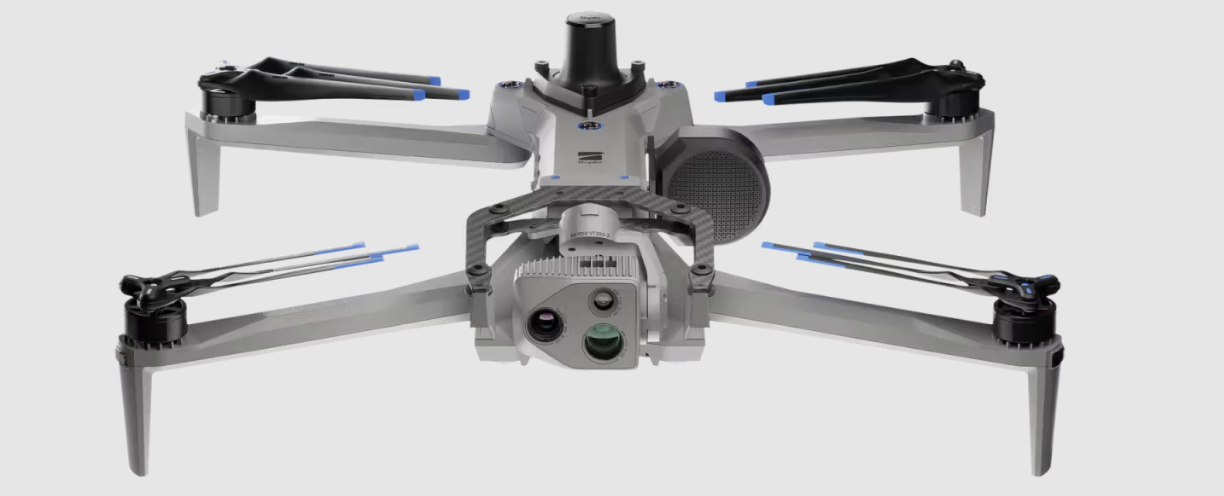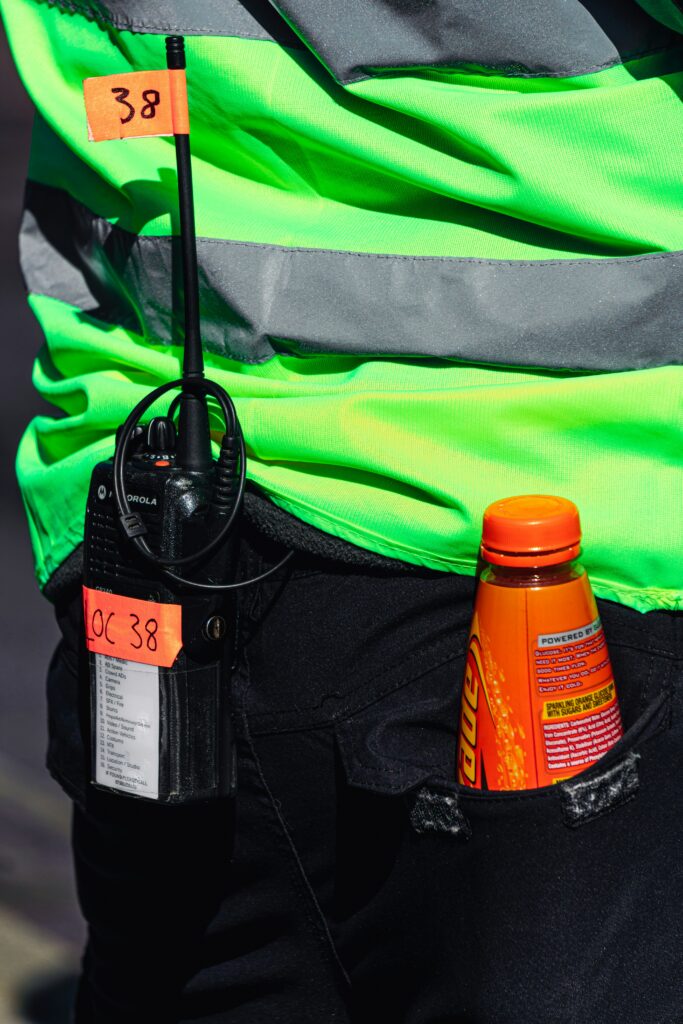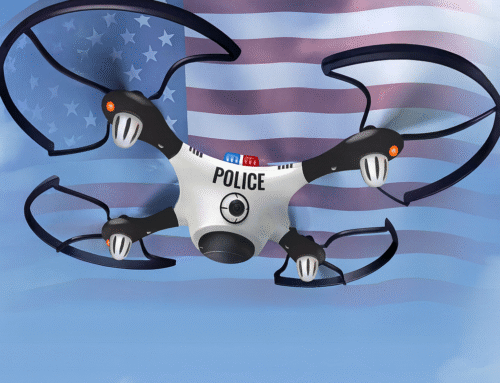Can a simple handheld radio really mess with your high-tech drone controller? If you fly a Skydio X10 series drone, there’s cause for concern. On 22 August, Skydio issued a Notice to Operators (NTO) warning that using a two-way radio too close to the X10’s controller can wreak havoc on your drone’s connection. In some cases, the controller could even shut down or “go dark” mid-operation. That’s a scary thought for any pilot – professional or hobbyist.
Let’s break down what this Skydio X10 Controller Radio Interference issue is all about, how it happens, what real-world impacts it can have, and most importantly, what you can do to fly safe.
Skydio’s Big Warning: Keep Radios Away from Your X10 Controller
As last week came to a close, Skydio put out a safety bulletin (OSB Number: SOSB-24-V) with the message: do not operate handheld radios within 12 inches (about 1 foot) of the Skydio X10 or X10D drone controller. Why? Because doing so can cause serious radio frequency interference. In plainer terms, a powerful radio too close to your controller can confuse or even disable the controller’s communication link with the drone.
The official notice explains that interference may “result in degraded performance” and could make the controller temporarily or even permanently inoperable. If that happens during flight, the controller could lose contact with the drone entirely – at which point the drone would initiate its failsafe “return-to-home” procedure due to lost connection.
Think about that. You’re flying an expensive Skydio X10, and someone next to you keys up a radio mic – suddenly your video feed stutters, the controller freezes, and the drone starts flying itself back home without waiting for your input. Not good!
Skydio’s bulletin specifically named popular public safety radio brands like Motorola and Kenwood as potentials to have effects, but noted it’s not limited to those. In fact, any high-powered radio transmitter (>1 W) used within about a foot of the controller (especially on the controller’s left side) can trigger problems. This means police or fire department handhelds, walkie-talkies, HAM radios, or similar devices can all pose a risk if they’re too close to your controller while transmitting.
What kind of problems are we talking about? According to Skydio, the interference can lead to a whole grab-bag of issues:
- Unstable or lost connection: You might get intermittent drop-outs or a total loss of communication between the controller and the drone. (Yes, that means your control inputs might not reach the drone at all.)
- Glitchy video feed: The live video stream could degrade into a pixelated, laggy mess, or freeze up entirely. Losing your eyes in the sky at a critical moment is the last thing you want.
- Unexpected Return-to-Home (RTH): The drone can think it’s out of range and automatically fly back to its launch point because it “thinks” the link is gone. This could interrupt missions or even create a hazard if you weren’t prepared for an RTH.
- Controller power issues: Perhaps the most startling – in some cases the interference can mess with the controller’s own electronics, causing it to stop charging properly or even power off when certain frequencies are used (specifically in the 450–500 MHz range). In other words, a strong UHF radio transmission right next to the controller can literally shut it down.
To put it bluntly, a $5,000+ drone system could be derailed by a $50 walkie-talkie if you’re not careful. It’s a rare convergence of everyday gear and high-tech drone equipment that caught many off guard.
How Can a Walkie-Talkie Disable a Drone Controller?
It sounds crazy that a handheld radio can interfere so badly with a drone controller – after all, they likely operate on very different frequencies, right? The Skydio X10’s controller uses a wireless link (like Wi-Fi frequencies around 2.4 GHz or 5.8 GHz) to talk to the drone. Meanwhile, public safety and two-way radios often use much lower frequencies (VHF/UHF bands, e.g. 450 MHz). They’re not even on the same channel, so what gives?
The issue comes down to pure physics and the brute force of radio energy. Public-safety handhelds typically transmit at 1 to 5 Watts of power, and they often operate in the UHF range (around 450 MHz, as well as 700–800 MHz for many police radios). When you transmit with that kind of power and the antenna is only a few inches from sensitive electronics, it’s like setting off a loudspeaker next to someone trying to listen to a whisper. The drone controller’s receiver is designed to pick up the drone’s signals, which are relatively weak and up in the GHz range. A blast of RF energy from a nearby radio can flood the controller’s circuitry with noise, even if it’s on a different frequency band. The result: the controller’s receiver gets “desensitized” or overwhelmed – essentially blinded by the radio blast.
Say you’re at a concert and someone starts shouting in your ear – you can’t hear the music well anymore. Similarly, the controller can’t “hear” the drone’s signals properly when a strong transmitter is screaming next to it. Technically, this is known as receiver blocking or front-end overload. The Skydio X10 controller’s radio front-end can be saturated by out-of-band interference if it’s strong enough. Electronics 101: a very strong signal can induce currents and voltages in circuits even if it’s not on the exact frequency the circuit is tuned for.
Skydio identified that frequencies in the 450–500 MHz range are particularly nasty for the X10 controller. These frequencies can couple into the controller’s circuitry and even disrupt power management. Strong UHF energy (like a 5 W radio at close range) can couple onto power/USB lines and upset charging ICs – basically scrambling the controller’s power regulation electronics. That explains why Skydio’s bulletin explicitly mentions charging failures or controller power loss at 450–500 MHz. It’s classic electromagnetic interference: a strong radio wave induces currents where it shouldn’t, causing devices to misbehave.
Another factor is antenna placement and shielding. Skydio pointed out the left side of the controller as the sensitive area. If a radio transmitter is held right near that side, the coupling is strongest there. Experts say this isn’t a quirk unique to Skydio – many drone controllers pack delicate receivers in plastic shells, which offer little shielding against a blasting radio nearby. Unless a controller is specifically hardened, putting a 5 W transmitter inches away will dump an huge amount of RF energy into it. The result is receiver overload, “desense,” and even component malfunctions as described. We’re basically talking about a near-field electromagnetic onslaught that standard consumer-grade designs never anticipated.
So, yes your drone controller can get knocked out by a walkie-talkie if the geometry and power levels are just right. It’s a bit like friendly fire in the radio spectrum. The Skydio X10 controller, like many others, wasn’t built to shrug off a powerful radio at point-blank range. It’s now clear that under those conditions, the X10’s link becomes vulnerable. In extreme cases the controller might freeze or shut off – which, of course, cuts off all control to the drone.
Notably, this issue isn’t entirely new. Insiders have indicated that similar interference was observed with Skydio’s earlier X2 drone systems way before this public bulletin came out. Both the X2 and X10 controllers reportedly use the same Microhard radio module for their communication link meaning they share the same strengths and weaknesses in RF performance. Strong UHF transmissions likely cause the 2.4 GHz front end to be overwhelmed through out-of-band coupling, which lines up perfectly with what we’re seeing in the 450 MHz interference scenario. In other words, blasting a 450 MHz signal near these controllers can indirectly trash the 2.4 GHz receiver inside by sheer brute force.
If this sounds like the kind of thing military jammers do – you’re not wrong. Counter-drone jamming equipment often works by pumping out noise on the control frequencies or saturating the drone’s receivers. Here, our “jammer” just happens to be a standard public safety radio used a little too close. It’s the same physics at play.
Small drones evolved from consumer gadgets, and they typically don’t expect a police officer’s radio or a firefighter’s walkie-talkie to be screaming in their ear. Now, as drones move into policing, search and rescue, and even defense, these electromagnetic blind spots are being exposed.
Real-World Impact: Why This Matters in the Field
Skydio’s warning came as many police and fire departments are rolling out Skydio X10 drones for field use. Drone-as-First-Responder (DFR) programs are expanding in cities across the U.S. Cities like Huntington Beach, CA (with multiple Skydio docking stations for rapid response) and Miami Beach, FL (using Skydio X10s for spring break crowd monitoring) have publicly touted their new Skydio deployments. With more drones on patrol, often side by side with officers and incident commanders, the chances of a radio and a controller getting too cozy increase.
Related Reading: Miami Beach PD Integrates Skydio DFR Program With Intelligence Center
For everyday drone hobbyists or commercial operators, you might not think this applies – but consider any event where radios are in use. Perhaps you’re volunteering with a search-and-rescue team, or filming on a set where walkie-talkies are used, or inspecting a site where security guards carry radios. The risk isn’t limited to cops and firefighters, though it’s most pronounced for them because they live in a sea of radio communications.
Let’s talk first responders: Police, fire, EMS, and search-and-rescue teams rely on radios constantly. Police typically use 700–800 MHz digital radios these days, which are a bit higher in frequency (and may not trigger the power-loss issue), but they can still cause interference if close enough. More critically, multi-agency operations often involve other bands. Firefighters and EMS often use VHF/UHF bands (around 150 MHz or 450 MHz) for on-scene comms, mutual aid channels, or older systems. There are nationwide interoperability channels like UCALL/UTAC in the 453–458 MHz range, and MED frequencies at 462/467 MHz for ambulance-to-hospital comms– all smack in the middle of the danger zone Skydio highlighted. Community emergency response teams and volunteer groups might use FRS/GMRS radios (around 462 MHz), again right there in the 450–500 MHz span.
Now picture a disaster response or a big accident scene. Police drone pilots have their Skydio controller on a command table. Nearby, a firefighter with a portable radio clipped to their jacket leans over to coordinate, or an EMS team member keys up their radio to call in patient info. If that radio is right next to the Skydio controller, the drone pilot could suddenly see “Lost Connection” on their screen and watch their drone head into fail-safe mode. In a critical moment, that could mean losing live overhead eyes on a suspect or a fire scene because someone needed to use their radio. Even leaving a radio on the same table as the controller is a risk – it doesn’t have to be in your hand transmitting right against it.
Consider big cities like New York or Los Angeles. NY’s PD and FD still operate heavily on UHF channels (around 470–512 MHz), including frequencies near 485 MHz. LAPD is similar, using the UHF T-band. These happen to overlap the very range that Skydio admitted can knock out charging and shutdown controllers. So for agencies in those cities, the interference threat isn’t a rare edge case – it’s potentially present every time they fly, if proper precautions aren’t taken. In such jurisdictions a Skydio controller could be vulnerable any time it’s powered on in proximity to an active police or fire radio. That’s a pretty eye-opening realization.
Have any drones actually crashed or been lost because of this? Thankfully, there are no widely publicized disaster stories – likely due to built-in safety features. When the controller disconnects, the Skydio X10 drone will autonomously return to home (or to a preset rally point) if it loses link for too long. This automated RTH minimizes the chance of a flyaway or crash even if you drop the connection. The scope of the problem is now much clearer and publicly acknowledged.
Even without a crash, the operational impact can be significant. A drone pilot might have to abort a mission because the feed keeps cutting out. Or they may waste precious time troubleshooting a controller that mysteriously won’t charge or power on (not realizing a radio was the culprit that fried it until later). For instance, imagine arriving at an emergency scene and your controller won’t turn on at all – Contact support if you see “persistent charging failure or failure to power on” as it could be a symptom of past interference damage. That could take your drone out of action completely until fixed.
The bottom line: If you’re using drones in any professional capacity alongside radios – you need to be aware of this interference issue and treat it seriously. As drones become standard kit for first responders, everyone on the team needs to know that you can’t plop a blaring handheld radio next to the drone controller. Spectrum discipline may sound like a luxury in the heat of a crisis, but ignoring it can literally ground your aircraft when you need it most.
To Skydio’s credit, they have been very transparent by issuing this bulletin and outlining the risks in detail. Not all manufacturers openly discuss such vulnerabilities. So, what are they doing about it and what steps you can take as an operator to mitigate the risk?
Skydio’s Response: Fixes, Updates, and Workarounds
Skydio isn’t just saying “good luck” and leaving users hanging. In the safety notice, they outlined both immediate precautions for operators and longer-term fixes they’re working on. Here’s the rundown of how Skydio is tackling the issue:
- Hardware Shielding Improvements: Skydio engineers are already working on redesigning or shielding components in future batches of the X10/X10D controller. This likely means adding better electromagnetic shielding inside the controller, using different materials or layouts that are less susceptible to RF blast, or otherwise “hardening” the device. Shielding could involve things like metal enclosures for the radio module, grounded RF shielding cans on circuit boards, RF absorbers, etc. The goal is to make future controllers far less vulnerable, so that a 5 W radio a foot away isn’t a showstopper. It’s a proactive admission that the current design has a weakness, but that it can be engineered out in the next iteration.
- Software Detection and Alerts: In addition to hardware changes, Skydio is planning a software update for the controller that will detect high interference conditions and warn the pilot in real-time. Essentially, the controller would monitor its signal quality and if it sees the telltale signs of interference (like sudden overload or unusual noise levels), it might pop up a warning like “Radio interference detected – move away from any transmitting radios.” This kind of alert can be a lifesaver because you might not immediately realize interference is the cause of a problem. If your controller warns you, you can instantly think, “Oh, I need to check for someone’s radio nearby.” Skydio said they will notify customers once this software feature is available. So, stay tuned for firmware updates – that future controller OS update could give you a heads-up before things get out of hand.
Those are Skydio’s in-house actions. Now, for pilots in the field, Skydio’s advice is straightforward (and you can implement it right now):
- Keep a 12-inch distance (at minimum) between any active radio and your controller. This is rule #1. It’s something you can brief your team on and enforce during operations. It might mean using a different table or area to set down radios, or simply being mindful if you’re holding a radio – don’t hold it right up against the controller when you key it. A foot of separation greatly reduces the strength of the RF field that reaches the controller (radio waves drop off exponentially with distance). That alone could solve most issues.
- Double-check your return-to-home (RTH) and lost-link settings before every flight. This is just good drone practice in general, but Skydio emphasizes it here. Make sure you’ve set a safe RTH altitude (to clear obstacles) and a suitable home point or rally point. And know what your drone will do if it loses contact (hover, land, RTH, etc., depending on settings). If interference does cause a disconnect, you want to be confident the drone will behave in a predictable, safe way. Don’t be scrambling to figure out where it will land or if it’s coming back. Set it and confirm.
- If you suspect interference or have weird controller issues, stop and troubleshoot. Skydio specifically says to contact support if your controller shows persistent charging failures or won’t power on after exposure to radios. That implies those symptoms might mean the interference did some damage or tripped something internally. Also, if you ever see the controller behaving oddly (unresponsive controls, etc.) during flight, one recommended step is to reboot the controller immediately. In an earlier bulletin for a separate issue, Skydio mentioned that if the X10 becomes unresponsive to inputs, rebooting the controller might restore control, and if not, powering it off forces a lost-link RTH. The same logic can apply if interference overwhelms your controller – a quick reboot could clear the condition once the radio source is moved away. Of course, that’s only if you have time and the drone is still flying safely on its own.
Beyond Skydio’s official guidance, what can you as an operator do? Here are some practical tips compiled from industry experts and common sense practices to mitigate interference:
- Position your radio wisely: If you’re wearing a radio or have one on your vest, try to mount it on the opposite side of your body from the controller. For example, hold the controller in your hands and keep your radio holstered on your back or right side if the controller’s vulnerable side is the left. This uses your body as additional shielding and keeps distance. Some recommend using remote speaker-mics (shoulder mics) so the actual radio can stay on your belt and you’re only holding a small mic near your face – not the whole transmitter near the controller.
- Enforce a “radio standoff” zone: If you’re running a drone operation with a team, establish a simple rule that no one keys a radio within a certain radius of the pilot or the command station. Even 2–3 feet of separation is better than nothing if 1 foot is the bare minimum. Make it part of your standard operating procedures that radios and drone controllers don’t mix in close quarters. This might mean if someone needs to transmit, they take a step away from the drone pilot. It sounds a bit inconvenient, but it beats having the drone disconnect at a critical time.
- Test your setup in training: Don’t wait for an emergency to find out you have an interference issue. During training drills, deliberately test the scenario – have someone key a radio near the controller (maybe start at 2–3 feet and cautiously move closer) while the drone is hovering, so you can observe effects in a controlled way. See if any warnings pop up or if the signal strength indicators go red. This can help gauge how robust your particular controller unit is and build awareness among team members about the risk. Some agencies have done RF interference testing as part of their drone program development, which is a smart move.
- Keep firmware up to date: When Skydio releases that interference detection feature or any other updates, install them. They continuously refine things. In the past, Skydio has rolled out improvements to radio performance via software – for instance, they tweaked the Skydio X2’s radio sensitivity in a 2022 update so it wouldn’t “overly de-sense” itself and hurt signal quality under interference. This gave the X2 better range and stability in noisy environments. We can expect similar optimizations in X10 software. Staying up to date ensures you have all the latest fixes.
At the end of the day, Skydio’s recommended workaround is remarkably simple: just keep radios and controllers at a safe distance. It costs nothing and is easy to do once you’re aware of the need. The challenge is mostly awareness – making sure all operators and nearby personnel know about the interference risk.







